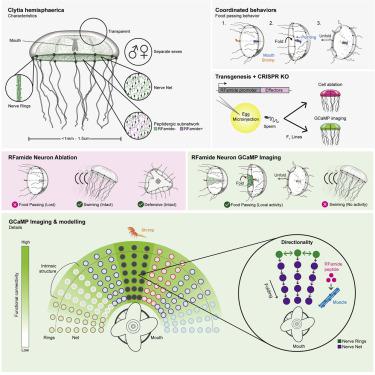Cell ( IF 64.5 ) Pub Date : 2021-11-24 , DOI: 10.1016/j.cell.2021.10.021 Brandon Weissbourd 1 , Tsuyoshi Momose 2 , Aditya Nair 1 , Ann Kennedy 1 , Bridgett Hunt 1 , David J Anderson 1

|
Jellyfish are radially symmetric organisms without a brain that arose more than 500 million years ago. They achieve organismal behaviors through coordinated interactions between autonomously functioning body parts. Jellyfish neurons have been studied electrophysiologically, but not at the systems level. We introduce Clytia hemisphaerica as a transparent, genetically tractable jellyfish model for systems and evolutionary neuroscience. We generate stable F1 transgenic lines for cell-type-specific conditional ablation and whole-organism GCaMP imaging. Using these tools and computational analyses, we find that an apparently diffuse network of RFamide-expressing umbrellar neurons is functionally subdivided into a series of spatially localized subassemblies whose synchronous activation controls directional food transfer from the tentacles to the mouth. These data reveal an unanticipated degree of structured neural organization in this species. Clytia affords a platform for systems-level studies of neural function, behavior, and evolution within a clade of marine organisms with growing ecological and economic importance.
中文翻译:

用于系统和进化神经科学的遗传易处理水母模型
水母是 5 亿多年前出现的没有大脑的径向对称生物。它们通过自主运作的身体部位之间的协调互动来实现有机体行为。水母神经元已在电生理学方面进行了研究,但并未在系统层面进行研究。我们介绍Clytia hemisphaerica作为系统和进化神经科学的透明、遗传易处理的水母模型。我们生成稳定的 F 1用于细胞类型特异性条件消融和全生物体 GCaMP 成像的转基因系。使用这些工具和计算分析,我们发现表达 RFamide 的伞状神经元的明显扩散网络在功能上细分为一系列空间局部化的子集,其同步激活控制从触手到嘴的定向食物转移。这些数据揭示了该物种的结构化神经组织程度出乎意料。Clytia提供了一个平台,用于系统级研究生态和经济重要性日益增长的海洋生物进化枝内的神经功能、行为和进化。



























 京公网安备 11010802027423号
京公网安备 11010802027423号